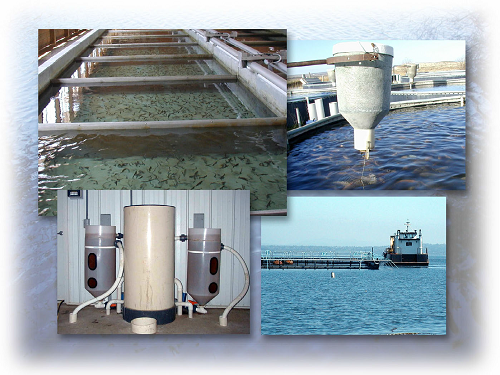Concentrated Aquatic Animal Production Effluent Guidelines

- Use flow-through, recirculating, or net pen systems
- Directly dischargeA point source that discharges pollutants to waters of the United States, such as streams, lakes, or oceans. wastewater
- Produce at least 100,000 pounds of fish, molluscs or crustaceans a year
- What is the CAAP Industry?
- Facilities Covered
- Guidance Document
- Rulemaking History
- Additional Information
What is the CAAP Industry?
Fish farms and hatcheries covered by the Effluent Guidelines regulation use one or more of the following systems.
Flow-through systems consist of raceways, ponds, or tanks that have constant flows of water through them. Trout, salmon, and hybrid striped bass are examples of fish grown in flow-through systems.
Recirculating systems are highly intensive culture systems that actively filter and reuse water many times before it is discharged. These systems typically use tanks or raceways to hold the growing animals and have extensive filtration and support equipment to maintain adequate water quality. Any species can be grown in a recirculating system, but tilapia and hybrid striped bass are the predominant species.
Net pens are floating structures in which nets are suspended into the water column in coastal waters and the open ocean. Net pen systems typically are located along a shore or pier or may be anchored and floating offshore. The most significant net pen operations are salmon net pens located in the northeastern and northwestern coastal areas of the United States. Other species, such as steelhead trout, cobia and redfish, also can be cultured in net pen operations.
Facilities Covered
- Flow-Through and Recirculating Systems
- Net Pen
Note: Fish farms and hatcheries producing less than 100,000 pounds/year, and other aquaculture systems such as ponds, are not subject to the CAAP Effluent Guidelines, but still require NPDES permits for discharging wastewater. See NPDES Aquaculture Permits.
Guidance Document
- Compliance Guide and Reporting Forms (2006)
The document helps permit writers develop wastewater discharge permits and producers comply with the requirements for their facilities.
Rulemaking History
2004 Rule
- Final Rule (August 23, 2004)
- Documents, including:
- Development Document
Industry description, wastewater characterization, treatment technologies, regulatory compliance cost estimates and pollutant loadings for the final rule - Economic & Environmental Benefits Analysis
- Development Document
- Proposed Rule (September 12, 2002)
Additional Information
For additional information regarding CAAP Effluent Guidelines, please contact Meghan Hessenauer (hessenauer.meghan@epa.gov) or 202-566-1040.
